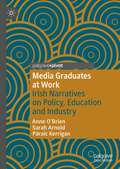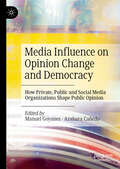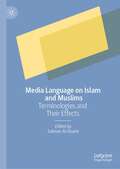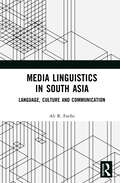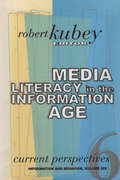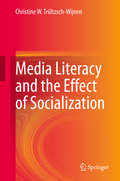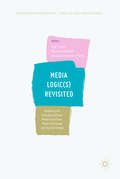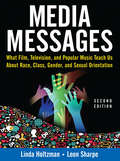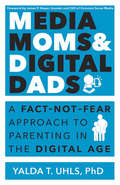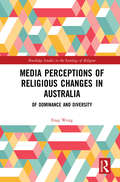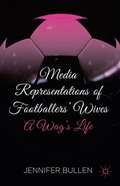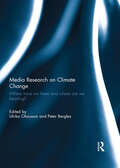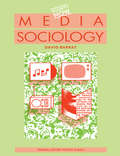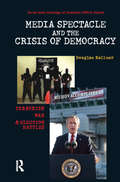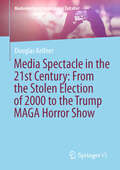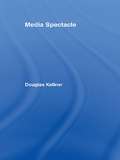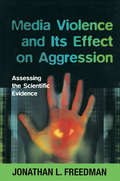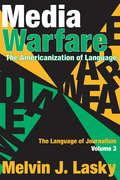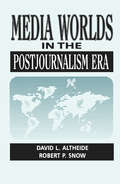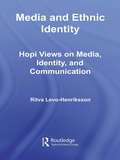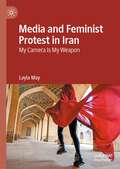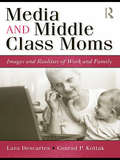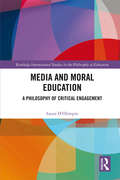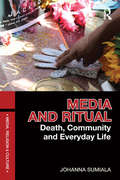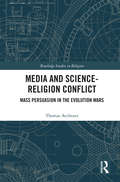- Table View
- List View
Media Graduates at Work: Irish Narratives on Policy, Education and Industry (Creative Working Lives)
by Anne O'Brien Sarah Arnold Páraic KerriganThis book systematically examines various factors that shape graduates’ entry into media work, which include the state and its policies, industrial and organizational practices and cultures, and media education. However, the book does not take a typical political economic or even media industries approach to this exploration. Rather, it innovatively traces how these forces are operationalized to shape media work from the perspective of the graduates, their educators and their employers. These varying perspectives are analyzed to see how graduates experience the outcomes of policy, education and industry cultures. The book examines the impact that policy, education and industry have in redefining what media work means for parts of industry that are responsible for cultivating new entrants into the creative industries.
Media Influence on Opinion Change and Democracy: How Private, Public and Social Media Organizations Shape Public Opinion
by Manuel Goyanes Azahara CañedoThis book reviews and advances the theoretical and empirical knowledge at the intersection of opinion change and democracy. Specifically, the volume addresses how opinion change and political persuasion unfold in three main domains of media effects: private media (i.e., news organizations), public service media (state-own media services), and social media platforms. Divided in these three different sections, the volume serves as a venue to discuss and further advance the most recent theoretical assumptions and empirical findings that underpin our current understanding on how media influence public opinion and shape liberal democracies. The book also explores how media literacy and critical thinking can mitigate the effects of misinformation and propaganda, emphasizing the importance of educating the public to discern credible information from deceptive content. Furthermore, it discusses the ethical implications of media practices and the responsibilities of media producers in maintaining the integrity of democratic discourse. By highlighting these aspects, the book provides a comprehensive understanding of the complex interplay between media, public opinion, and democracy, offering valuable insights for scholars, policymakers, and anyone interested in the role of media in shaping public opinion.
Media Language on Islam and Muslims: Terminologies and Their Effects
by Salman Al-AzamiThis book brings together contributions from ten academics and a commentary from a Muslim community leader on how the British media represent some of the most important terminologies related to Islam and Muslims. It takes a nuanced approach to language within Muslims in the media research by focusing on terminologies. Each contributor in this volume focused on one terminology and its associated words to show how the representation of these terminologies have major implications on the lives of British Muslims. The book also includes some key recommendations on the usage of these terms from the Media Style Guide of the Centre for Media monitoring - a research organisation of the Muslim Council of Britain. This book’s link with the Muslim community can be a step towards new approaches in this field where academics will engage with communities and practitioners to ensure better impact of their academic works. This book will be of interest to students, scholars and practitioners in a range of fields, including Journalism, Media and Communication Studies, English Language and Linguistics, Sociology, Cultural and Religious Studies.
Media Linguistics in South Asia: Language, Culture and Communication
by Ali R FatihiThe tone and texture of the language of media have changed considerably due to the rapid expansion of media in recent times and advancements in communication technologies. This book examines new ways to conduct linguistic explorations into the myriad of forms news is being presented and consumed. The volume contributes to the emerging field of media linguistics by measuring and analysing the associations between linguistics and the news discourse. It extends the conceptualization of language-media relations in sociolinguistics beyond the notions of ‘influence’ and ‘effect’ and broadens the theoretical and empirical scope of the discipline. The author discusses different perspectives of media linguistics; issues of variation in language of media; question of plurilingual resources; parallel language use in media and textuality of news genres. He further analyses the dynamics of news reportage by studying the coverage of conflicts, violence and dissent in South Asian media in recent decades along with the reportage of cricket headlines and news. Comprehensive and topical this volume will be useful for scholars and researchers of linguistics, media linguistics, applied linguistics, media studies, media sociology, sociology, cultural studies and South Asian studies.
Media Literacy Around the World (Information and Behavior Series)
by Robert KubeyAt the dawn of the twenty-first century, education about and through the media has become a worldwide phenomenon, and is playing an increasingly important role in educational reform. The theory and practice of media education have profited greatly from recent and intensive development and application of new information and telecommunications technologies. Consequently, the importance of media and information literacy is taking on an even greater urgency. With this in mind, the contributors to this volume survey what has taken place over the last decade in different parts of the world, examine the current state of theoretical, conceptual, and research development, and consider where media education is going and where it ought to go. With two-thirds of its 22 contributions coming from outside the United States, Media Literacy around the World is a genuine international effort, with many leading media and information educators in the world taking part. The work converts the notion of globalism from a slogan into a working hypothesis. The concerns in this volume are with literacy not just in computer technology, but as a broad concern of the educational process.
Media Literacy and the Effect of Socialization
by Christine W. Trültzsch-WijnenThis book explores the socially and individually determined nature of media literacy, addressing the central question of how individuals’ media activity can be explained and evaluated. It examines people's media activity through the relationship between their competence to act and actual actions. Further, the book discusses the social factors that foster self-determined media activity, including people's abilities and skills and the associated knowledge that facilitates such skills, from the perspectives of various social science disciplines. Lastly, it applies these theoretical reflections to two empirical studies. Overall, this book provides a fundamental introduction to theories of media socialization, media literacy and media competence, and to the relation between media and socialization. It analyses international discourses on children, media, media literacy, and digital literacy. This book is of interest to scholars and researchers in the field of media studies, including media sociology and media education, communication, and cultural studies.
Media Logic: Modelling The Interplay Between Media Institutions, Media Technology And Societal Change (Transforming Communications - Studies In Cross-media Research Ser.)
by Caja Thimm Mario Anastasiadis Jessica Einspänner-PflockThis volume provides new approaches to the concept of media logics - developed by Altheide and Snow - by drawing on theoretical and empirical perspectives from international scientists working in the field of communications, media, political science, and sociology. In an increasingly digitized and globalized world, powerful media structures and technologies influence our daily lives in many respects. It is not only mass media but 'poly media channels' that become more and more contextualized in everyday lives. Therefore, it is necessary to revisit the theory of media logics, which focuses on the strong intercorrelation of media technologies, media institutions and media power. Media Logic(s) Revisited attends to this by critically reflecting on the idea of media logic, a much needed input in light of current developments and strong cultural embedding of media in various social contexts.
Media Messages: What Film, Television, and Popular Music Teach Us About Race, Class, Gender, and Sexual Orientation
by Linda Holtzman Leon SharpeThe new edition of this widely adopted book reveals how the popular media contribute to widespread myths and misunderstanding about cultural diversity. While focused on the impact of television, feature film, and popular music, the authors reach far beyond media to explore how our understanding, values, and beliefs about race, class, gender and sexual orientation are constructed. They analyze how personal histories, combined with the collective history of oppression and liberation, contribute to stereotypes and misinformation, as well as how personal engagement with media can impact prospects for individual and social freedom. Along with updated media examples, expanded theories and analysis, this edition explores even more deeply the coverage of race in two chapters, discusses more broadly how men and boys are depicted in the media and socialized, and how class issues have become even more visible since the Great Recession of the 21st century and the Occupy movements. Special activities and exercises are provided in the book and an online Instructor's Manual is available to adopters.
Media Moms and Digital Dads: A Fact Not Fear Approach to Parenting in the Digital Age
by Yalda T. UhlsA new media was unleashed upon the world and children took to it like ducks to water. Young people everywhere devoured its content, spending hours upon end immersed in it, while simultaneously ignoring the adults in their lives. Parents were understandably alarmed and worried that this new media was ruining young minds. It may surprise you to know that this new media was not the Internet, radio, or television but rather the 19th-century novel. Yes, parents were concerned that reading too much Jane Austin was going to ruin their children. Fast-forward to today and we are still having the same conversation. Will digital media, in its various forms, ruin our children? In Media Moms & Digital Dads, former film producer turned child psychologist Yalda Uhls cautions parents not to be afraid of the changing state of media but to deal with the realities of how our kids engage with it. The truth is children today spend more time with media than they do with parents or in schools. And as parents, many of us did not have early exposure to the Internet, mobile phones, and gaming, making the world of our children somewhat foreign to us. The key, says Uhls, is to understand the pros and cons of media so that parents can make informed decisions about cause and effect, boundaries and exposure. Uhls debunks the myths around media by delving into the extensive body of social science research, proving that our kids are all right, and that parents can and must adapt to help their children thrive in the digital age. This ground-breaking book will draw back the curtain and reveal the truth-often surprising and counterintuitive, and other times reassuring-in order to help guide the conversation about our digital age and the future of childhood.
Media Perceptions of Religious Changes in Australia: Of Dominance and Diversity (Routledge Studies in the Sociology of Religion)
by Enqi WengThis volume explores the contradiction between the news coverage given to issues of religion, particularly since 2001 in relation to issues such as terrorism, politics, security and gender, and the fact of its apparent decline according to Census data. Based on media research in Australia, and offering comparisons with the UK, the author demonstrates that media discussions overlook the diversity that exists within religions, particularly the country’s main religion, Christianity, and presents religion according to specific interpretations shaped by race, class and gender, which in turn result in very limited understandings of religion itself. Drawing on understandings of the sacred as a non-negotiable value present in religious and secular form, Media Perceptions of Religious Changes in Australia calls for a broader sociological perspective on religion and will appeal to scholars of sociology and media studies with interests in religion and public life.
Media Representations of Footballers� Wives
by Jennifer BullenRepresenting a detailed analysis of footballers' wives and their role in contemporary British culture, this books explores how the generic and stereotypical 'Wag' has been created by newspaper and magazine coverage, auto/biographies and influential television programmes.
Media Research on Climate Change: Where have we been and where are we heading?
by Ulrika Olausson and Peter BerglezResearch on media coverage of climate change, as a particular subfield of environmental communication research, has proliferated over the past decade. This book sets out to consider what conclusions can be drawn in light of the existing body of work, what lessons can be learnt, what are the challenges to be met, and what are the directions to be taken in order to further develop media research on climate change. The mixture of articles in this volume serve well to illustrate the range of empirical, theoretical, and methodological approaches subsumed under the broad heading of "media studies on climate change." Some contributions focus on the past—how the subfield has developed and what we can learn from that—and some look toward the future. Either way, all the authors share the ambition to suggest important avenues of research, be they centered on media, context, applicability of results, or theoretical advancement. As such they make a valuable contribution to identifying important directions for future research on the role of the media in communicating climate change. This book was previously published as a special issue of Environmental Communication.
Media Sociology (Society Now)
by David BarratThe British post-war campaign to ban American horror comics neatly illustrates many of the pitfalls of media research. It is the first case-study used by David Barrat as he reviews this rapidly growing field of sociology. He gives a clear account of how and why sociologists have studied the media, looking in particular at the arguments about the effects of television, video, comics, newspapers, and radio on their audiences.He explains how media organizations work, how 'news' is manufactured, and what the political and commercial constraints can be. He discusses the likely impact on new technologies, including satellite and cable television, on the media industry. The final chapter is about methods of studying the media, such as 'uses and gratifications', content analysis, semiology and structural approaches.
Media Spectacle and the Crisis of Democracy: Terrorism, War, and Election Battles
by Douglas KellnerDouglas Kellner's Media Spectacle and the Crisis of Democracy: 9/11, the War on Iraq, and Election 2004 investigates the role of the media in the momentous political events of the past four years. Beginning with the role of the media in contested election of 2000, Kellner examines how corporate media ownership and concentration, linked with a rightward shift of establishment media, have disadvantaged the Democrats and benefited George W. Bush and the Republicans. Exploring the role of media spectacle in the 9/11 attacks and subsequent Terror War in Afghanistan and Iraq, Kellner documents the centrality of media politics in advancing foreign policy agendas and militarism. Building on his analysis in Media Spectacle (Routledge 2003), Kellner demonstrates in detail how conflicting political forces ranging from Al Qaeda to the Bush administration construct media spectacles to advance their politics. Two chapters critically engage the role of the media in the buildup to the Iraq war and the media-centric nature of Bush's Iraq invasion and occupation. Final chapters delineate the role of the media in the highly contested and significant 2004 election campaign that many believe to be one of the key political struggles of the contemporary era. Criticizing Bush's unilateralism, Kellner argues for a multilateral and cosmopolitan globalization and the need for democratic media to help overcome the current crisis of democracy in the United States.
Media Spectacle in the 21st Century: From the Stolen Election of 2000 to the Trump MAGA Horror Show (Medienkulturen im digitalen Zeitalter)
by Douglas KellnerThis book offers an original analysis of the primacy of media spectacle in the politics, social history, and major events of the 21st century which highlights the importance of critical analysis and interpretation of broadcasting, the Internet, and social meaning in understanding the key historical events and the multiple factors that produce them during the contemporary era. The text explores how broadcasting and digital media constitute the major media spectacles of our time and how they in turn present the key issues, challenges, conflicts, and problems of the present era. Thus understanding broadcasting and digital media help us to understand our contemporary society, politics, and culture and to play a more active role in understanding and participating in our contemporary media societies and environments. Kellner argues throughout for the need for critical media and digital literacies to empower students and citizens to become active participants in our media society and technoculture and to understand the key events and challenges of contemporary life. Douglas Kellner has been researching, writing about, and lecturing upon the major topics and studies in this book for the last several decades and this book brings together key aspects of his work on theorizing, analyzing, and evaluating the role of effects of major media spectacles of the 21st century.
Media Spectacle: Donald Trump, Media Spectacle, And Authoritarian Populism (Transgressions: Cultural Studies And Education Ser. #117)
by Douglas KellnerDuring the mid-1990s, the O.J. Simpson murder trial dominated the media in the United States and were circulated throughout the world via global communications networks. The case became a spectacle of race, gender, class and violence, bringing in elements of domestic melodrama, crime drama and legal drama. According to this fascinating new book, the Simpson case was just one example of what the author calls 'media spectacle' - a form of media culture that puts contemporary dreams, nightmares, fantasies and values on display. Through the analysis of several such media spectacles - including Elvis, The X Files, Michael Jordan, and the Bill Clinton sex scandals - Doug Kellner draws out important insights into media, journalism, the public sphere and politics in an era of new technologies. In this excellent follow up to his best selling Media Culture, Kellner's fascinating new volume delivers an informative read for students of sociology, culture and media.
Media Violence and its Effect on Aggression
by Jonathan L. FreedmanThe scientific evidence does not support the notion that TV and film violence cause aggression in children or in anyone else. So argues Jonathan Freedman, based on his findings that far fewer than half of the scientific studies have found a causal connection between exposure to media violence and aggression or crime. In fact, Freedman believes that, taken to a more controversial extreme, the research could be interpreted as showing that there is no causal effect of media violence at all.Media Violence and its Effect on Aggression offers a provocative challenge to the accepted norms in media studies and psychology. Freedman begins with a comprehensive review of all the research on the effect of violent movies and television on aggression and crime. Having shown the lack of scientific support for the prevailing belief that media violence is connected to violent behaviour, he then explains why something that seems so intuitive and even obvious might be incorrect and goes on to provide plausible reasons why media violence might not have bad effects on children. He contrasts the supposed effects of TV violence on crime with the known effects of poverty and other social factors, and discusses the difference between television advertising, which, he argues, does have an effect, and violent programs, which do not. Freedman concludes by noting that in recent years television and films have been as violent as ever and violent video games have become more and more popular, yet during this period there has been a dramatic decrease in violent crime. He argues that this makes it highly implausible that media violence causes aggression or crime.
Media Warfare: The Americanization of Language (Language Of Journalism Ser.)
by Melvin J. LaskyMedia Warfare is the concluding volume of Melvin Lasky's monumental The Language of Journalism, a series that has been praised as a ""brilliant"" and ""original"" study in communications and contemporary language. Firmly rooted in the critical tradition of H. L. Mencken, George Orwell, and Karl Kraus, Lasky's incisive analysis of journalistic usage and misusage gauges both the cultural and political health of contemporary society as well the declining standards of contemporary journalism.As in the first two volumes, Lasky's scope is cross-cultural with special emphasis on the sometimes conflicting, sometimes mutually influential styles of American and British journalistic practice. His approach to changes in media content and style is closely keyed to changes in society at large. Media Warfare pays particular attention to the gradual easing and near disappearance of censorship rules in the 1960s and after and the attendant effects on electronic and print media. In lively and irreverent prose, Lasky anatomizes the dilemmas posed by the entrance of formerly ""unmentionable"" subjects into daily journalistic discourse, whether for reasons of profit or accurate reporting. He details the pervasive and often indirect influence of the worlds of fashion and advertising on journalism with their imperatives of sensationalism and novelty and, by contrast, how the freeing of language and subject matter in literature--the novels of Joyce and Lawrence, the poetry of Philip Larkin--have affected permissible expression for good or ill. Lasky also relates this interaction of high and low style to the spread of American urban slang, often with Yiddish roots and sometimes the occasion of anti-Semitic reaction, into the common parlance of British no less than American journalists.Media Warfare concludes with prescriptive thoughts on how journalism might still be revitalized in a ""post-profane"" culture. Witty, timely, and deeply learned, the three volumes of The Language of Journalism are a c
Media Worlds in the Postjournalism Era (Communication And Social Order Ser.)
by David AltheideThe concept of media logic, a theoretical framework for explaining the relationship between mass media and culture, was first introduced in Altheide and Snow's influential work, Media Logic. In Media Worlds in the Postjournalism Era, the authors expand their analysis of how organizational considerations promote a distinctive media logic, which in turn is conductive to a media culture. They trace the ethnography of that media culture, including the knowledge, techniques, and assumptions that encourage media professionals to acquire particular cognitive and evaluative criteria and thereby present events primarily for the media's own ends.
Media and Ethnic Identity: Hopi Views on Media, Identity, and Communication (Indigenous Peoples and Politics #2)
by Ritva Levo-HenrikssonMedia and Ethnic Identity carries a Native American perspective to media and its role in ethnic identity construction. This perspective is gained through a case study of the Hopis, who live in northeast Arizona and are known for their devotion to their indigenous culture. The research data is built on a number of interviews with Hopis of a variety of ages from nine villages. The study also makes use of the results of a survey of a large number of students in the Hopi Jr./Sr. High School. The framework for examining the research data is intercultural communication (both interpersonal and media-mediated) between an indigenous group and a majority from the viewpoint of the indigenous group. This book provides tools for understanding the experiences of communication between social and political minorities and majorities from the indigenous perspective.
Media and Feminist Protest in Iran: My Camera Is My Weapon
by Layla MayThis book provides an analysis of social media and women’s resistance in Iran with relevance to similar polities. The author examines how Iranian women continue to fight against the regime’s gender discriminatory laws and protest the government in public squares and in virtual spaces. The book presents a critical approach to technology’s role in politics and society and an in-depth analysis of authoritarianism and its relationship to social media harms and state violence. With a particular focus on images, hashtags, and other digital content, it calls for a rethinking of the concepts of crime, culture, and control in the technosocial world. The author draws on conceptual contributions from the fields of criminology, philosophy, psychology, technology and media studies.
Media and Middle Class Moms: Images and Realities of Work and Family
by Conrad Kottak Lara J. DescartesWritten by nationally recognized anthropologists Conrad Kottak and Lara Descartes, this ethnography of largely white, middle class families in a town in the midwest explores the role that the media play in influencing how those families cope with everyday work/family issues. The book insightfully reports that families struggle with, and make work/family decisions based largely on the images and ideas they receive from media sources, though they strongly deny being so influenced. An ideal book for teaching undergraduate family, media, and methods courses.
Media and Moral Education: A Philosophy of Critical Engagement (Routledge International Studies in the Philosophy of Education)
by Laura D'OlimpioMedia and Moral Education demonstrates that the study of philosophy can be used to enhance critical thinking skills, which are sorely needed in today’s technological age. It addresses the current oversight of the educational environment not keeping pace with rapid advances in technology, despite the fact that educating students to engage critically and compassionately with others via online media is of the utmost importance. <P><P>D’Olimpio claims that philosophical thinking skills support the adoption of an attitude she calls critical perspectivism, which she applies in the book to international multimedia examples. The author also suggests that the Community of Inquiry – a pedagogy practised by advocates of Philosophy for Children – creates a space in which participants can practise being critically perspectival, and can be conducted with all age levels in a classroom or public setting, making it beneficial in shaping democratic and discerning citizens. <P><P>This book will be of interest to academics, researchers and postgraduate students in the areas of philosophy of education, philosophy, education, critical theory and communication, film and media studies.
Media and Ritual: Death, Community and Everyday Life (Media, Religion and Culture)
by Johanna SumialaThis wide-ranging and accessible book offers a stimulating introduction to the field of media anthropology and the study of religious ritual. Johanna Sumiala explores the interweaving of rituals, communication and community. She uses the tools of anthropological enquiry to examine a variety of media events, including the death of Michael Jackson, a royal wedding and the transgressive actions which took place in Abu Ghraib, and to understand the inner significance of the media coverage of such events. The book deals with theories of ritual, media as ritual including reception, production and representation, and rituals of death in the media. It will be invaluable to students and scholars alike across media, religion and anthropology.
Media and Science-Religion Conflict: Mass Persuasion in the Evolution Wars (Routledge Studies in Religion)
by Thomas AechtnerThis book examines why the religion-science skirmishes known as the Evolution Wars have persisted into the 21st century. It does so by considering the influences of mass media in relation to decision-making research and the Elaboration Likelihood Model, one of the most authoritative persuasion theories. The book’s analysis concentrates on the expression of cues, or cognitive mental shortcuts, in Darwin-sceptic and counter-creationist broadcasts. A multiyear collection of media generated by the most prominent Darwin-sceptic organizations is surveyed, along with rival publications from supporters of evolutionary theory described as the pro-evolutionists. The analysed materials include works produced by Young Earth Creationist and Intelligent Design media makers, New Atheist pacesetters, as well as both agnostic and religious supporters of evolution. These cues are shown to function as subtle but effective means of shaping public opinion, including appeals to expertise, claims that ideas are being censored, and the tactical use of statistics and technical jargon. Contending that persuasive mass media is a decisive component of science-religion controversies, this book will be of keen interest to scholars of Religion, Science and Religion interactions, as well as researchers of Media and Communication Studies more generally.
